|
Eurasia had appeared in 1976.
It was announced as an inferior model of Diamond which was a high class model of Bridgestone.
The front triangle of the frame was made of Cr-Mo, and the front fork was made of high-tension steel.
|
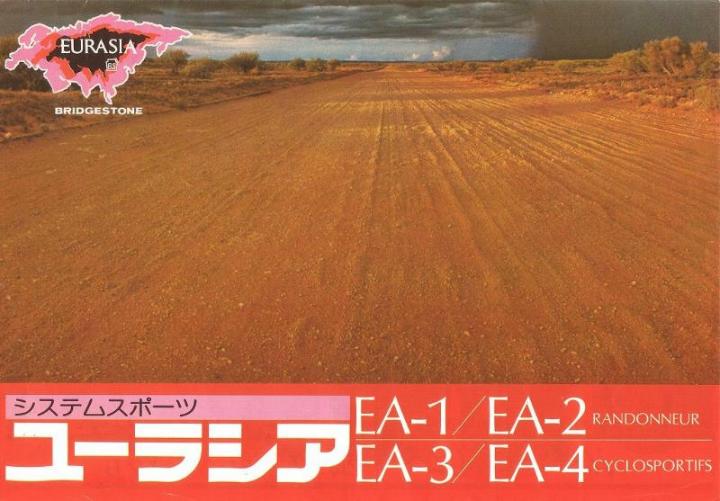
|
|
|
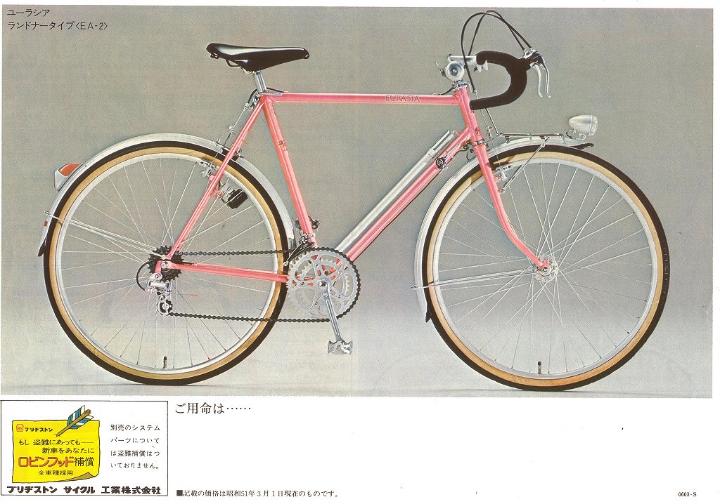
|
|
|
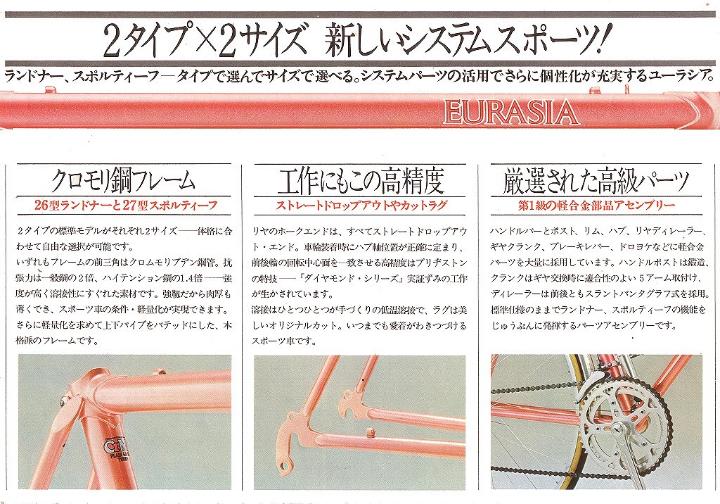
|
|
|
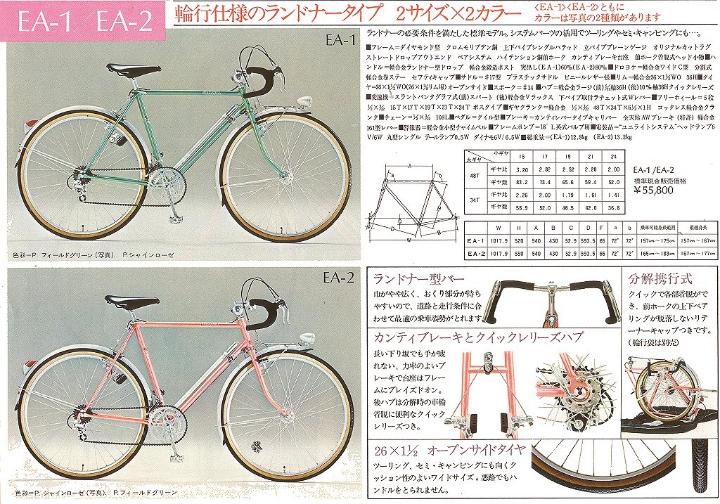
|
|
|
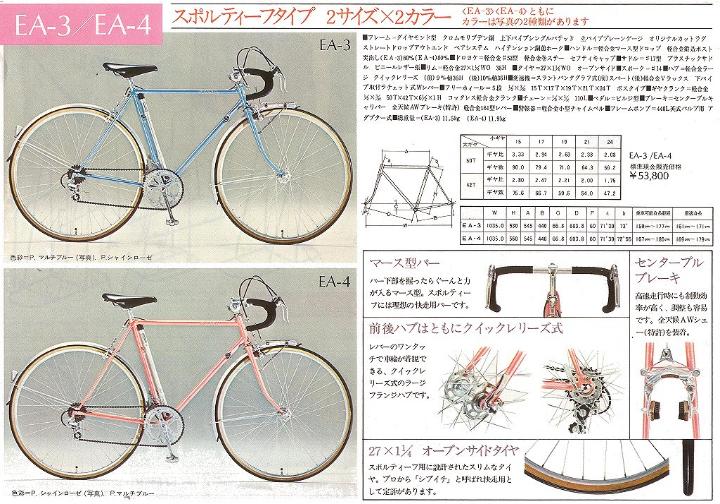
|
|
|

|
|
|
|
|
|
The specification |
|
EA-1/ EA-2 |
| Frame | Basic specification | Cr-Mo for front triangle (single batted for horizontal tube/ plane for stand tube), High-tension steel for front fork, original Italian-cut lugs, straight drop end , micro adjuster head set for pulling out a front fork |
| Special works | Cantilever brake plinth, bear system, sifter wire lead, dynamo plinth, pomp pegs | |
| Skelton | Frame size: 520/ 550, top tube: 540, rear center: 430, angle: 72 degree parallel, fork offset: 65, hunger: 53 | |
| Color | P. field green, P. shine rose | |
| Wheel | Hub | Sanshin large flange (36H, F96-R124), Quick-release for only rear |
| Spoke | Steel #14 plane | |
| Rim | Araya 26*1-3/8 WO(36H) | |
| Tire | 26*1-1/2 open-side (over size English bulb) | |
| Fender | Wide C model, separate type for rear, aluminum stay | |
| Drive system | Chain wheel | Sugino New Maxy 1 (165mm 48*34T), outer ring was fix type |
| Freewheel | Suntour perfect (15-17-19-21-24T) | |
| Chain | 1/2*3/32 108L | |
| Pedal | Mikashima quil 2K / tow clip and strap were options | |
| Derailleur | Fornt | Suntour Spart (Top normal model) |
| Rear | Suntour V-lux | |
| Sift lever | Suntour PDL-M (Power shifter with a built-in ratchet) | |
| Brake | Body | Yoshigai #960 Cantilever (the shoe was BS original all weather type) |
| Lever | Yoshigai #161 (quick release), pad was option | |
| Handle | Handle bar | Sakae randonneur bar |
| Stem | Sakae forging | |
| Bar tape | Cotton | |
| Saddle | Saddle | #17 Plastic type |
| Seat pillar | Aluminum | |
| Seat pin | Kyokuto quick seat pin | |
| Electric Equipment | Head light | Round type single (6V-6W) / Mitsuba? |
| Dynamo | 6V-6.5W / Mitsuba? | |
| Tail light | BS original (6V-0.5W) | |
| Others | Pomp | Primus hosetube type |
| Front carrier | 5 mm steel rod (possible to attach a flash light) |
|
EA-3/ EA-4 |
| Frame | Basic specification | Cr-Mo for front triangle (single batted for horizontal tube/ plane for stand tube), High-tension steel for front fork, original Italian-cut lugs, straight drop frame end , micro adjuster head set for pulling out front fork |
| Special works | bear system, sifter wire lead | |
| Skelton | Frame size: 530/ 560, top tube:545, rear center: 440, angle: 71.5* 73 degree, fork offset: 60, hunger: 67 | |
| Color | P. multi blue, P. shine rose | |
| Wheel | Hub | Sanshin large flange (36H, F96-R124), Quick-release for front and rear |
| Spoke | Steel #14 plane | |
| Rim | Araya 27*1-1/4 WO(36H) | |
| Tire | 27*1-1/4 open-side (English bulb) | |
| Fender | #52 type aluminum stay | |
| Drive system | Chain wheel | Sugino New Maxy 1 (165mm 50*42T), Outer ring was fix type |
| Freewheel | Suntour perfect (15-17-19-21-24T) | |
| Chain | 1/2*3/32 108L | |
| Pedal | Mikashima max K / tow clip and strap were options | |
| Derailleur | Fornt | Suntour Spart (Top normal model) |
| Rear | Suntour V-lux | |
| Sift lever | Suntour PDL-M (Power shifter with a built-in ratchet) | |
| Brake | Body | Yoshigai #610 Center-pull (the shoe was BS original all weather type) |
| Lever | Yoshigai #161 (quick release), pad was option | |
| Handle | Handle bar | Sakae mouse bar |
| Stem | Sakae forging | |
| Bar tape | Cotton | |
| Seat | Saddle | #17 Plastic type |
| Seat pillar | Aluminum | |
| Seat pin | Hexagon bolt | |
| Electric Equipment | Head light | Non |
| Dynamo | Non | |
| Tail Reflector | BS original reflector | |
| Others | Pomp | Primus adopter type |
| Front carrier | 5 mm steel rod (possible to attach a flash light) |